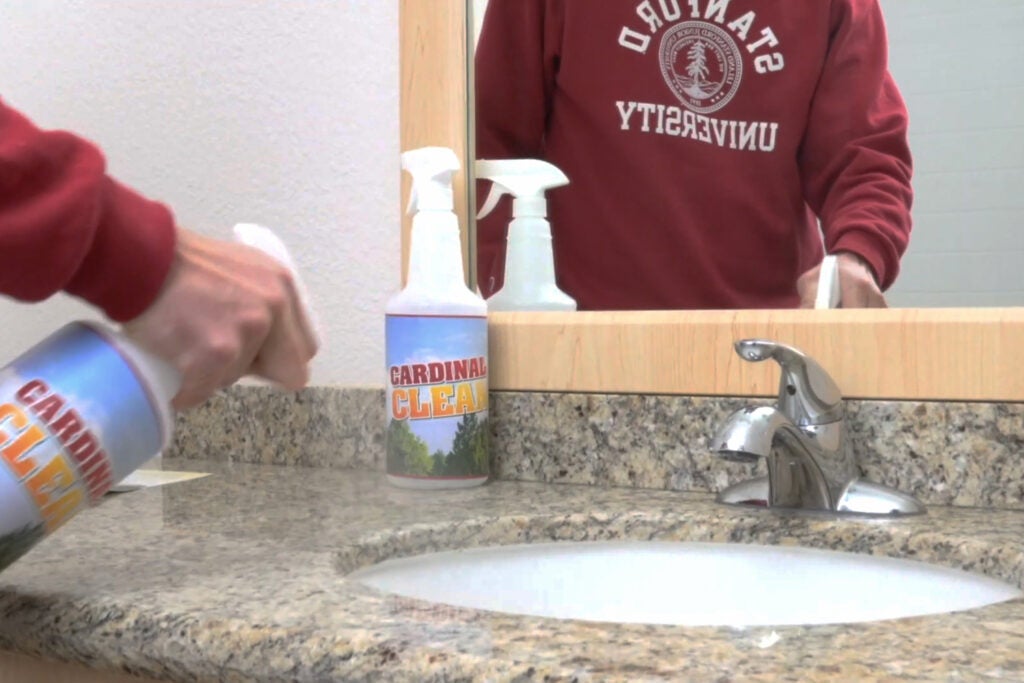It’s not just clean, it’s Cardinal Clean
More than 100 student residences and campus offices are using a system that turns tap water into an ozone-based disinfectant that cleans everything from laundry to bathroom surfaces.
A cleaning product that’s free, easy to use, saves money, and helps the environment almost sounds too good to be true. But that’s exactly what Stanford students and staff are using to clean their dorms, apartments, and workspaces.
Cardinal Clean is a high-tech, ozone-based green cleaning system that is revolutionizing how the Stanford community cleans and disinfects. In the eight years since the system was introduced, Cardinal Clean has replaced approximately 5,500 gallons of potentially environmentally hazardous chemical cleaners annually (a 90 percent decrease) – and spared their containers from the landfill.
“It’s almost not even worth calling it green cleaning because it’s so much better,” said Kristin Parineh, director of the Office of Sustainability.
Stanford’s investment in Cardinal Clean is garnering praise from environmental groups. Last week, the Office of Sustainability and Residential and Dining Enterprises (R&DE) accepted the Outstanding Waste Prevention Award from the California Resource Recovery Association (CRRA) at a ceremony in Burlingame.
“This award represents what we’re all ultimately trying to achieve, which is prevention of waste in the first place,” said Parineh, who accepted the award with Mike VanFossen, assistant vice provost for R&DE Maintenance Operations & Capital Projects.
How it works
Cardinal Clean machines – which use technology developed by Tersano – are located in laundry rooms and custodial closets in most student residences and some office buildings on campus. Users turn on the cold water faucet, then flip a switch, (watch an instructional video), which applies 4,500 volts of electricity to the water, turning it into ozone, a potent and naturally occurring disinfectant that’s stronger than bleach. Using a nozzle, users dispense the solution into a refillable spray bottle. The result is what Parineh calls “engineered water” that can clean and disinfect all surfaces, including floors, carpets, windows, toilets, cell phones, and computers.

From left, CRRA President Laura McKaughan, Mike VanFossen, Kristin Parineh, and CRRA Executive Director Tracie Onstad Bills pose with the Outstanding Waste Prevention Award on Monday, Aug. 14, 2023. (Image credit: Courtesy Residential & Dining Enterprises)
“It is just as effective at killing viruses and bacteria as traditional chemical-based cleaners, and it is faster and longer acting,” she said.
Within a minute of being applied to a surface, the solution eliminates odors, stains, mold, mildew, viruses, and bacteria, including E. coli and salmonella, and hundreds of other common germs. The ozone water has a very minor electrical smell, is colorless, safe to touch, and converts back to water within seven days.
R&DE first introduced the technology in select student residences in 2015 following the recommendation of a student. Today, it is used in more than 100 buildings on campus and over 6 million square feet of space. Stanford is also the first university in the country to offer the technology for student use. Imogen Hinds, assistant vice provost for R&DE Student Housing Operations and Stanford Conferences who oversaw the installation of Cardinal Clean, said that thousands of students currently have free and unlimited access to the machines to clean their dorms and apartments.
“We’ve just completed installation of machines in all undergraduate buildings, and we were able to open the EVGR graduate housing with it,” she said. “Over the next four years, we will fully implement the system throughout all graduate residences.”
Emily Blackwell is a coterminal student studying sustainability science and practice. As a sustainability intern with R&DE last year, she worked closely with the Cardinal Clean machines, including performing maintenance checks, studying machine efficacy, and gathering feedback from custodians.
“While working on the Cardinal Clean program this past year, I learned the importance of social change management in implementing sustainable technologies for the fight against climate change,” she said, noting the benefits it provides to the campus community. “Beyond the invaluable experience of taking part in Stanford’s ‘living laboratory,’ it is worth noting that the outcomes of these projects have direct benefits to the student population.”
Positive outcomes
Cardinal Clean has helped Stanford move closer to its goal of zero-waste by 2030, since buildings that use the product no longer buy, ship, and dispose of chemical cleaning containers. Stanford’s use of Cardinal Clean prevents the disposal of at least 2,146 pounds of plastic cleaning containers annually. In addition to the environmental and safety benefits, Stanford has also saved considerably on the cost of traditional cleaning products.
“Beyond the invaluable experience of taking part in Stanford’s ‘living laboratory,’ it is worth noting that the outcomes of these projects have direct benefits to the student population.”
—Emily Blackwell
“What we’re trying to do in the sustainability field is meet the triple bottom line, which is doing the right thing for the planet, for people, and for financial prosperity,” Parineh said. “Finding solutions to problems that make all three of those positive can be really challenging, but Cardinal Clean does just that.”
Shirley Everett, senior associate vice provost for R&DE and senior advisor to the provost of equity and inclusion, said Cardinal Clean is one example of a student-supported sustainability solution implemented on campus that can be replicated elsewhere.
“Sustainability is a core value for R&DE, and we are constantly exploring innovative ways to increase sustainability in our operations,” Everett said. “I am especially gratified to see this essential program expanding to the broader community. We are pleased to offer Cardinal Clean as a multipurpose solution for students in their residences and appreciate their engagement in partnering with us to develop the program.”
Parineh said that several units across Stanford have expressed interest in Cardinal Clean, including the Stanford Research Park, and Stanford Redwood City, which recently acquired machines.
“The goal is to continue to expand this across the Stanford campus and share the story with others to scale its use,” she said.
